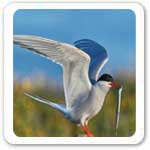Longest Migration Bird, Longest Migratory Seabird or Animal

Sooty Shearwater is known as the longest migratory bird in the world. It has been recorded that this bird travels about 64,000 kilometers distance each year. It has migrated to New Zealand, North America, South America, Antarctica and Africa. They breed on small islands in South Pacific and South Atlantis Oceans, New Zealand, Auckland Islands, Phillip Island and the Falkland Islands. They are amazing long distance migrants, they start their journey from New Zealand, and reach Japan, Alaska and California in a sequence, though complete average distance of 500 kilometers per day. The natural habitat of these birds is found in New Zealand in the form of colonies.
Arctic Tern was also known to be the longest migratory bird but the distance it has covered has not been recorded ever, because of the small size of this bird it cannot be tracked by electronic tracking technology. It travels from Arctic to Antarctic Ocean each year hence completing about 30,000 kilometers distance. It has also migrated to Africa, Europe, Asia and North and South America. They are found in Arctic regions that is why they are called Arctic Tern.
Pectoral Sandpiper is the third longest migratory birds. They have travelled the distance of 18,000 kilometers per year. They travels from South America, North America, Asia (Siberia) and Australia. They are the fresh-water habitats. It feed on small invertebrates.
These Migratory Birds use sun as the compass for navigating in the day time. While at night they use celestial navigations to find their way. They learn in their early ages about the positions of the stars, and know that stars remain at their marks and only earth moves.
Magnetite is the small mineral grains on the nostrils of birds, which help them in navigating with the magnetic field.
Before starting their journey the birds eat more, or become hyperphagic. So that they can store a large amount of fat in their body about 3 to 5 % of their total mass, which can be utilize later during the journey.


